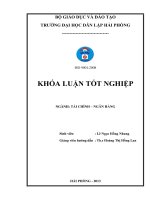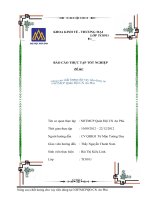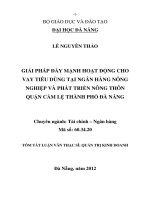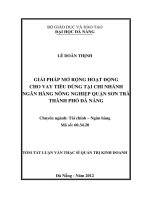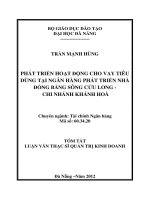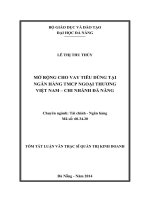consumer lending - the case of techcombank = cho vay tiêu dùng trường hợp của techcombank
Bạn đang xem bản rút gọn của tài liệu. Xem và tải ngay bản đầy đủ của tài liệu tại đây (1.29 MB, 85 trang )
0
VIETNAM NATIONAL UNIVERSITY, HANOI
SCHOOL OF BUSINESS
HOÀNG MỸ
CONSUMER LENDING IMPROVEMENT –
THE CASE STUDY OF TECHCOMBANK
MASTER OF BUSINESS ADMINISTRATION THESIS
Hanoi, 2010
4
TABLE OF CONTENTS
ACKNOWLEDGEMENT
ABSTRACT
TÓM TẮT
TABLE OF CONTENTS
LIST OF FIGURES AND TABLES
EXECUTIVE SUMMARY
INTRODUCTION
1
Background to the issue ………………………………….
9
2
Problem Statement and Research Objectives of the study
10
3
Scope and Limitation of the Research …………………
11
4
Research Methodology ………………………………….
12
5
Research Structure ………………………………………
12
Chapter 1: COMMERCIAL BANK’S CONSUMER LENDING -
THEORETICAL FRAMEWORK FOR ANALYSIC
1.1
The Basis of Bank Lending …………………………….
14
1.2
The Basis of Consumer Lending ……………………….
17
1.2.1
The Concept of Consumer Lending ……………………
17
1.2.2
The Nature of Consumer Lending ………………………
18
1.2.3
The Types of Consumer Loans …………………………
19
5
1.2.4
The Effects of Consumer Lending ……………………….
24
1.2.5
The Factors Impacts on Consumer Lending ……………
25
1.3
The Process of Consumer Lending……………………
27
1.3.1
Receiving application and collecting information ………
28
1.3.2
Evaluating applications ………………………………….
29
1.3.3
Approving loans …………………………………………
32
1.3.4
Managing and collecting loans …………………………
33
1.4
Precautions to be taken in granting consumer loans …
34
1.5
Pricing and structuring of consumer loans
35
1.5.1
Loan pricing ……………………………………………
35
1.5.2
Loan structuring …………………………………………
37
1.6
Consumer Lending Quality …………………………….
37
1.6.1
Consumer Lending Quality from Different Perspectives
37
1.6.2
Measuring the Quality Consumer Lending ………………
39
Chapter 2: CURRENT SITUATION OF CONSUMER LENDING
AT TECHCOMBANK
2.1
Techcombank profile …………………………………….
44
2.1.1
History and Development ………………………………
44
2.1.2
Vision and Mission ………………………………………
46
6
2.1.3
Techcombank‟s Organization ……………………………
46
2.1.4
The Products ……………………………………………
47
2.1.5
Achievements …………………………………………….
47
2.2
Current Situation of Techcombank’s Consumer Lending
47
2.2.1
Consumer Lending Process ………………………………
47
2.2.2
Consumer Lending Quality ………………………………
52
2.2.3
Quality of consumer loans ……………………………….
56
2.2.4
Quality of Service ………………………………………
58
2.3
Assessment of the Techcombank’s Consumer Lending Quality
……………………………………………………
62
2.4
Development Trend of Techcombank’s Consumer Lending
…………………………………………………
66
Chapter 3: CONCLUSIONS AND RECOMMENDATIONS
3.1
Conclusions ………………………………………………
68
3.2
Recommendations ………………………………………
69
3.2.1
Developing the Outstanding of Consumer Loans ………
69
3.2.2
Increasing in Capital Mobilization ………………………
70
3.2.3
Clarifying the Responsibility of Professional Divisions ….
70
3.2.4
Applying and Revising the Credit Scoring System ……….
71
7
3.2.5
Applying Up-to-date Technology and Modern Equipments
72
3.2.6
Following Some Tactics in Evaluating Applications and
Mitigating Credit Risk ……………………………………
73
3.2.7
Expanding the Key Performance Indicators (KPIs) ………
74
3.2.8
Increasing the Quality of Information Provided by the Credit
Information Centre ………………………………
74
3.2.9
Enhancing Human Resource Quality ……………………
74
3.2.10
Responding to Changing Consumer Need and Purchasing
Behavior …………………………………………………
76
3.3
Limitations of the Research and Recommendations for
Further Study
77
REFERENCES…………………………………………… 79
APENDIXES………………………………………………. 81
APPENDIX 1- QUESTIONNAIRE
APPENDIX 2- TECHCOMBANK ORGANIZATION CHART
APPENDIX 3: TECHCOMBANK‟S PRODUCTS
8
LIST OF FIGURES AND TABLES
Figures
Figure 1.1: Credit process
Figure 2.1: Techcombank‟s Current Approving Process
Figure 2.2 : Techcombank Outstanding of Cunsumer and Commercial Loans
2005-2008
Figure 2.3: Techcombank‟s non-performance loan situation from 2005 to
2008
Figure 2.4: Portfolios and quality of consumer loan by products in 2008
Figure 2.5: Satisfaction marks on products
Figure 2.6: Level of Techcombank meeting clients‟ expectation
Figure 2.7: the ratio of Non-performance loan/ outstanding of Techcombank
2007
Tables
Table23.1: Some Main Figures of Techcombank
Table 2.2 : Techcombank‟s outstanding of consumer and commercial loans
Table 2.3: Techcombank‟s non-performing loan situation from 2005 to
2008
Table 2.4 : Portfolios and quality of consumer loan on products in 2008
9
EXECUTIVE SUMMARY
This research mentions to both theory and empirical study of consumer
lending. After revising the basis of bank lending, the basis of consumer
lending including concepts, nature, types, effects of consumer lending and
impact of technology on consumer lending, is focused. The common process
of consumer lending is deeply researched in the writing containing four
stages such as Receiving application and Collecting information, Evaluating
application, Approval and (Managing and Collecting loans. At each stage,
the readers can approach concise matters of the procedure which is
implemented by banks from the beginning to the end of consumer lending
process. Especially, the thesis also analyses and compares the two primary
methods of evaluating loan application such as judgmental analysis and
credit scoring system. Next, the precautions to be taken in granting
consumer loans, the pricing and structuring loans are also mentioned. The
quality of consumer lending is paid much consideration by the author.
Additionally, the writing discusses the quality of consumer lending and
several quantitative and qualitative criteria to measure the consumer
lending quality. Moreover, based on the study of the process and quality of
consumer lending, the thesis raises a case study of the Vietnam
Technological and Commercial Joint Stock Bank (Techcombank) in order to
better understand the circumstance. Follow the overview of Techcombank,
the writing mentions to the consumer lending process, quality as well as the
assessment of its customer lending performance. Lastly, some
recommendations for a development of Techcombank’s consumer lending in
terms of market, procedure and quality are proposed.
10
INTRODUCTION
1. Background to the issue
Based on the aim of credit using, financial institutions divides their credit
portfolio into two types of loans namely business loans and consumer loans.
Business credit is credits supplying for customers to support their business
activities such as building workshops, purchasing machinery, materials or
goods or other expenditure in trading and producing process. The subject of
main customers of commercial loans is enterprises. Besides, financial
institutions also provide loans to individuals or their families to help them
cover living cost as medical fee, learning expenses, buying houses, cars or
motorcycles, etc called consumer loans. The second type of lending activity
is also the subject of the research.
When income and living standard increase, it certainly leads people to the
change in spending habits, thus they are oriented to spend more. Again,
consumer debt is an element encouraging the economy growth. Since the
1920s, American manufacturers have relied ever-increasingly on consumer
loans to absorb the tremendous productivity increases of mass production, in
other words, consumer credit made mass consumption possible. To financial
institutions, consumer lending is of the most profitability with reasonable
risks.
Vietnam has witnessed a high growth rate of people, improved average
earnings and considerable changes in spending behavior of individuals in
recent time. In particular, the young age people who have a stable occupation
and income, demands in more consumptions. Therefore, looking for the
financial solutions such as bank‟s consumer loans is completely
understandable. Identifying that market trend, understanding the role and
prosperity of this lending category, banks continuously increase the
11
proportion of consumer loans in their credit portfolio. Nevertheless, for a
firm development of consumer lending, it is vital for Vietnamese
commercial banks to have overview and deep insight in consumer lending
activity, in order to evaluate the quality of the bank‟s consumer lending
situation and give out some prompt and reasonable solutions.
In this context, the Vietnam Technological and Commercial Joint Stock
Bank - Techcombank is selected as a case study for this research.
Techcombank is customer driven institution supplying a wide range of high
quality services to customers. In terms of individuals, Techcombank
provides a variety of financial services including demand deposit accounts,
savings, loans, payments, credit and debit cards, investment, guarantees, and
safe custody facilities. The key products to these customers are cards,
personal loans, and home loan. These assets obtain over 30% of
Techcombank‟s loan portfolio. However, along with the current rivals and
new comers of advanced technology, professional management and sound
strategy, this bank will be under the pressure of harder competition. Given
these facts, it is necessary for the bank to clearly define weaknesses and
strengths of its consumer lending performance and address suitable solution
for not only the improvement of consumer lending quality but also the
expansion of this activity.
2. Problem Statement and Research Objectives of the study
Obviously, the consumer lending is implemented by almost commercial
banks. However, there is a lack of efficiency in this activity, for instance,
complicated procedure, time-consuming lending process, shortage and
imperfection of information, lack of regulation, inexperienced staff, poor
loan monitor, etc. The consequences are high proportion of un-performing
loans and risk problems of capital loss. And Techcombank is a bank of high
percentage of consumer loans in the credit portfolio and individual
12
customer‟s targeting, the research attempts to explore the process and the
quality of consumer lending, thus, propose some recommendations through
analyzing a case study of Techcombank. The research objectives are:
To review the fundamental issues related to consumer lending in
order to study the necessity and complexity of controlling quality of
consumer lending;
To enumerate the precautions to be taken in evaluating consumer
loan applications;
To analyze the current situation of Techcombank‟s consumer
lending in order to identify the problems exisiting and new findings
regarding to the consumer credit activities and quality controls; And
finally, based on these new findings and the development trend of
the Techcombank,
To propose some solutions and recommendations to improve the
quality of consumer lending and to expand the bank‟s consumer
lending market in the future.
3. Scope and Limitation of the Research
The research focuses only on the literature of consumer lending and process
of consumer loan applications. It does not cover the business lending or
commercial lending of financial institution.
Consumer lending is carried out by most financial institutions, however, the
research is aimed at examining only the process and evaluating the quality of
the consumer lending through a specific case of the Vietnam Technological
and Commercial Joint Stock Bank; other financial institutions are excluded.
The quality of data is not updated enough (for analysis the Techcombank
performance, the data is collected from up to the year of 2008).
13
Data used for assessing consumer lending quality is not sufficient because
information is extracted from the bank‟s survey, not the author‟s survey.
Only secondary data is used for this writing.
4. Research Methodology
Research Approach and Strategy: The paper uses the inductive approach,
in which data are collected, analyzed and interpreted to answer the
research questions. The researcher has chosen the research strategy of
carrying out a case study, which involves an empirical investigation of a
particular bank, Techcombank. It allows the researcher to gain a rich
understanding of the on-going consumer lending performance of a
Vietnam‟s commercial bank within its real context.
Data collection methods: The study exploits the secondary data which are
acquired through official data records of the selected bank, bank‟s
profile, bank‟s former research findings, bank‟s business reports, and
individual customer satisfaction survey of Techcombank. Magazines,
newspapers and Internet are among other potential sources of secondary
data.
5. Research Structure
Given the research objectives, the study is organized as follows:
Introduction: This chapter includes the background of the study, problem
statement, research objectives and methodology used to obtain data and
information, scope and limitation of the research.
Chapter 1 – Theoretical Framework: This chapter provides a theoretical
framework for the study of bank lending in general and consumer lending in
particular. The chapter also emphasizes on how commercial banks process
consumer loan application and how they measure the quality of their
consumer lending activity.
14
Chapter 2 – Case Study of Techcombank: This chapter identifies the current
performance of consumer lending in Techcombank; and analyzes the
procedures of processing consumer loan which are implemented by related
departments. Apart from an illustration of the Techcombank‟s current
approving process, a comparison of the Techcombank‟s consumer lending
quality with the benchmark (the Hong Kong and Shanghai Bank Coporation)
is implemented to investigate strong and weak points of the bank. Especially,
the quality of consumer loans of this bank is also assessed by the customer
satisfaction survey conducted by the bank itself.
Chapter 3 – Conclusions and Recommendations: This chapter provides
conclusions and suggestions on the issue to the readers for their own
assessment. Conclusions on the issue are summarized; recommendations for
improvements and expansion of consumer lending of Techcombank and
other banks are listed. The chapter also concludes the limitation of the paper
and gives recommendations for further research.
15
Chapter 1:
COMMERCIAL BANK‟S CONSUMER LENDING -
THEORETICAL FRAMEWORK FOR ANALYSIC
This chapter will firstly study the basis of bank lending and the more
details in basis of consumer lending activity, for example, concept, nature,
types, effect of consumer lending. The process and measurement of
consumer lending are also mentioned.
1.1. The Basis of Bank Lending
Financial intermediation is the focus of lending. It is the process of how
surplus funds are collected and then dispersed through the financial markets,
from surplus units to deficit units. For many decades, primarily banks carried
out this function.
The basic principles of good lending are safety of loan, suitability of loan
purpose and profitability (Weerasooriya, 1998).
Safety of loan- This principle requires that a loan is granted to only that
borrower who is considered safe. A safe borrower is one who is of good
character, is financially sound and has the ability and willingness to repay
the loan. In addition, the lender should account for meeting an unexpected
emergency. Such an emergency could arise when assumptions about the
borrower turn out to be wrong, or when circumstances change so
dramatically that assumptions made when the loan is made do net remain
relevant. Lending institutions wherefore often require a back-up for the loan
in the form of collateral security. The collateral serves as a safety valve or
insurance against unforeseen developments.
Suitability of loan purpose- a loan can be given for any valid purpose. A
valid purpose is one that is legal and conforms to the lending policy of the
16
bank. A bank cannot lend for an activity that is not legal. Can you imagine a
bank giving a loan for an illegal activity, such as the heroin trade? It cannot,
because such trade is not legal. Other purposes for which a financial
institution cannot lend include gambling. If a bank starts financing gamblers,
then it world soon go into liquidation! Suitability of purpose is also
important for the safety of the loan. If a loan is granted for an illegal
purpose, then the lender may not be able to recover the money because the
case may not stand in any court of law. A purpose may be perfectly legal and
valid, yet a lender may still refuse to finance it. This may occur where the
loan purpose is outside the lending policy of that institution.
Profitability- Financial institutions are in the business of lending to earn
profits. Lenders will compare the cost and benefit of a loan before granting
it. Interest on loans and advances is a major source of income for any bank.
Lending institutions must carefully weigh the risks and returns from a
possible loan. This raises the issue of appropriate pricing of loans, as well as
that of minimizing loan costs.
Indeed, loans should be given to borrowers of good character and good
creditworthiness, for approved purposes, and result in profit for the bank.
Whether the purpose of a loan is for meeting personal needs, financing small
business, financing a dairy activity or financing an export trade, the
principles of lending still apply. Again, whether the loan is for an amount of
a few thousand dollars or may million dollars, the principles of lending still
apply. To follow these principles, financial institutions undertake credit
analysis of all loan proposals.
On the contrary, lending is often regarded as an art and not a science because
lending needs much practice, so experience counts. A top banker in Australia
once said that anyone can lend, but it is lending money and ensuring its
repayment in time together with interest that distinguishes between a good
17
banker and a bad banker. When making a loan, credit officer is dealing with
people and it is almost impossible to predict how someone will behave in
future. It is crucial therefore that lenders exercise sound judgment while
granting a loan. However, the principles are not laws of physical science that
must hold whatever be the case; rather, the principles serve as a framework
within which to make a decision.
Lending decisions are taken within a framework of external factors such as
macroeconomic policies, monetary policies and other regulatory restrictions;
internal factors such as lending institutions‟ strategic objectives, lending
programs and staff availability; and borrower - specific factors such as
character, capacity, capital, conditions, and collateral (Sathye, et al., 2003)
Principally, there are broadly two types of borrower: personal borrowers and
business borrowers. Individuals and households are considered to be
personal borrowers. Business borrowers may take many forms, including a
sole proprietorship, partnership, limited company and so on. There are also
special types of borrowers, such as schools, clubs, and literary societies.
Additionally, in a lending institution, credit culture is very important. It
means the institutional priorities, traditions and philosophies that surround
credit or lending decisions. Credit cultures vary among banks. For instance,
some banks have a higher tolerance or willingness for risk than others. The
level of risk-taking in the loan portfolio is determined in part by the bank‟s
possibilities for loan diversification as well as by management‟s objectives.
In shortly, the lending function is among the most important activities, if not
the most important activity, of a financial institution. It provides income and
cash flow run-off that can be allocated to new asset creation and ultimately
allocated as year-end profit. Poor lending can lead to doubtful or bad debts
and, therefore, adversely affect the results. Some write-offs are unavoidable
because the reason for the loss arose after the advance. A large proportion is
18
avoidable, however, if care in the analysis and approval process is increased
and if awareness of the real causes of loss is generated. A large body of
evidence suggests that up to 30 per cent of all loan write-offs are bad at the
time of approval; the lender just failed to notice or failed to correctly analyze
the customer. It is important to understand that only a small proportion of
loan failures result from fraudulent actions; there is more danger from errors
in the loan approval process than from a loss due to fraud.
1.2. The Basis of Consumer Lending
1.2.1. The Concept of Consumer Lending
Consumer lending generally refers to the loans that individuals or
households require to meet personal needs such as travel or the purchase of
furniture, household appliances, motor vehicles or homes. Weaver and
Shanahan (1994) state that „consumer finance is a broad term covering
lending to personal rather than business or corporate customers, for a wide
variety of worthwhile purposes‟. They state that the most common forms of
consumer lending are personal loans and credit cards. According to Fischer
and Massey (1994), „consumer credits are loans to individuals for private,
non-business purposes used to finance the purchase of consumer durables
and services, including motor vehicles, home improvements, daily life
expenditures, travel expenditures and paying off other debts for private
consumption, but excluding home investments, such as the purchase of a
residential property or financing the repayment of a mortgage or a small part
of the capital borrowed‟.
Consumer loans may be defined as types of loans made to finance
consumption, rather than productive purposes.
19
1.2.2. The Nature of Consumer Lending
Scale of individual business is usually small while the cost related to this
matter is rather high, therefore, consumer credit interest usually higher than
commercial credit.
Consumer needs depend on the national economic situation. As commodity
prices increase, people will tighten their purse-strings. Moreover, if the
national economy faces more difficulties, the financial institutions also face
higher risk in consumer credit. In contrast, economic development improves
life quality and pushes up consumer credit.
Income and collateral also affect consumer spending behaviors. High income
people prefer to consumer loan and the banks give priority to those
customers because of their higher probability of repayment of interest and
principal.
It is hard to evaluate ethics of clients as it is qualitative assessment, credit
officers usually base on their feeling to judge customers. Hence, the
sensitivity and experience of credit staff are very important for quality of
consumer loans.
Although innovations in the financial services industry during the last couple
of decades have boosted the variety of credit available to consumers, bank
loans (installment loans and credit cards) continue to be an important source
of credit.
Across time, banks‟ supply of credit varies in accordance with changes in
consumers‟ credit quality. If bank credit standards remain constant over the
business cycle, supply will decrease during recessions as consumers‟ balance
sheets deteriorate. However, supply may also decrease if banks experience a
shortfall of funds.
20
1.2.3. The Types of Consumer Loans
In the consequent fierce competition in the consumer loan market, banks
have devised credit plans to accommodate the financial needs of the
consumers. There are several different types of consumer loan. These loans
can be classified by purpose, by the term of the loan, by the terms of
repayment or by security. If we consider purpose-related categories,
consumer loans include loans for the purchase of residential homes,
investment properties, holidays, higher studies, household furniture, cars,
shares and many other such purposes. If we categorize consumer loans by
the term of the loan, consumer loans include short-term loans (loans
generally for a period of up to one year), medium-term loans (loans for a
period of one to five years) and long-term loans (loans for a period of more
than five years). Yet another classification is by the mode of repayment:
installment loans are short-term to medium-term loans that are repayable in
monthly or quarterly installments, while non-installment loans are drawn by
consumers to meets an emergency and generally are repaid in one lump sum.
The use of security is a further classification. When a loan is given against a
security of a property of the borrower, it is called a secured loan. In a
secured loan, the credit provider enjoys rights conferred by contract over the
property, which are exercisable in the event of the customer‟s default under
the credit contract (Duggan & Lanyon, 1999). When a loan is given without
obtaining security, it is called a clean loan or unsecured credit.
In this writing, consumer loans are divided into three major types including
personal loans, home loans/real estate loans and credit card loans.
Personal Loans
Households generally require personal loans for the purchase of items such
as furniture, home appliances, and motor vehicles. These loans may also be
taken to consolidate existing household debts. They are generally repayable
21
in monthly or quarterly installments that extend over two to five years and
carry a fixed rate of interest. In recent years, variable interest rate personal
loans have become more common. Some banks in the United States have set
up separate finance companies to handle these types of loan, because finance
companies can give riskier loans than those of banks, which may be
restricted by regulations. Personal loans can be negotiated with banks
directly; that is, the borrower visits the bank, submits a loan application and
obtains a loan, which he/she then uses for buying the desired asset.
Alternatively, banks may indirectly give these loans. A motor vehicle dealer,
for example, may enter into an agreement with the bank whereby the bank
may provide finance to the dealers‟ customers (called auto-finance). The
dealer will obtain a loan application from the customer, negotiate terms of
the loan with that customer and then present the application to the bank.
Personal loans could be installment loans or non- installment loans.
Installment loans, the interest the principal are repaid in equal monthly or
other such installments, as agreed by the bank and the customer. These loans
could be secured or unsecured. The security for an installment loan is
generally the asset (a motor vehicle) purchased out of the loan. Unsecured
installment loans are given to borrowers with a high credit standing who
have been customers of the bank for a long time.
Personal loans can be overdrafts or non-installment loans. Overdrafts are
also known as revolving line of credit. Overdraft literally means an
overdrawing of the account. The bank allows the customer to withdraw
amounts larger than the credit balance in the account. It will charge the
customer interest on the over drawn amount. In non-installment loans, the
entire loan is repayable in one lump sum or could be in the form of a line-of-
credit facility. Such loans are usually of a relatively small amount and
repayable in a lump sum in a period of around one month. These types of
22
loan are often given to finance a holiday, to meet medical and hospital care
expenses or to pay for home repairs.
Home Loans or Real Estate Loans
Loans that are made for financing the purchase of a home or to fund
improvements to a private residential block come under the general category
of home loans. These loans are also called residential mortgage loans or real
estate loans, and are often made for longer periods of time, ranging from ten
to thirty years (In Vietnam it ranges from ten to twenty years). They are
secured by the mortgage of the property against which the loans are made.
Home loans are such a special class of consumer loans. They require a
reasonalble understanding of property laws, mortgage underwriting
practices, mortgage insurance, financial analysis, property valuation
principles, tax law, investment analysis and the home loan market. Home
loans can be broadly categorized into loans for owner-occupied properties
and loans for financing and investing in income-producing properties. The
distinction is important because the repayment of these two types of home
loan is expected to come from different sources. Owner-occupied home
loans are generally paid out of the household income of the owners, while
investment home loans are generally repaid out of the rental income of the
property. Accordingly, the repayment capacity of an applicant is assessed
differently in these two types of loan.
Secured housing finance is the largest single type of personal loan. This form
of advance has a number of distinct features, including longer maturity,
repayments in equal month installments, low risk compared with that of
other types of consumer loan (because the property is collateral), a well-
established system of financing, and high income from fees. Home lending is
a lucrative portfolio for banks.
23
Interest rates on loans generally take two forms. Fixed interest rates do not
change over a set period, the interest rate remains fixed for one year, three
years or five years. Generally, fixed interest rates are higher than variable
interest rates, because the lender is bearing the interest rate risk. Where fixed
interest rates are charged, repayments are set for the duration of the loan
period, regardless of any movement in market interest rates. Banks issue
variable rate consumer loans, for which the interest rate varies as conditions
change in the market. In Vietnam, almost banks calculate loan‟s interest
based on interest rate of saving accounts of the 12 month term plus a margin
and the rate changes periodically.
In accordance with the development of the financial market, the home loan
products become more sophisticated with line of credit loans and home loans
with redraw. Line of credit loans are any loan with a fixed limit (the amount
of funds can be borrowed) the borrowers are able to withdraw funds up to
the limit. A fixed limit will not change unless the borrower and the lender
agree to change it. The borrowers are usually required to make payments to
at least cover the interest and fees on the loan. In the United State of
America, most home loans now come with the option of redraw, so called
home loans with redraw. This means that the borrower can access any
additional funds paid into the home loan. This type of loan is different from
a line of credit loan, as the limit is not fixed. The limit on the loan decreases
each month by the amount of the borrower‟s scheduled repayments. One
enormous advantage with redraw is that the borrower can place his savings
in his home loan, save on interest costs and be able to withdraw that money
if needed. The disadvantages of redraw and line of credit loans are that the
draw funds are very tempting (to spend). In effect, most home loans now
operate like an overdraft account and it is easy to end up with no additional
24
payments made, or in the case of credit loans, find that your loan is not
reducing at all.
Credit Card (Loans)
Credit cards are fast becoming popular as a means of meeting personal
financial needs. Although several banks and nonbank credit card companies
issue credit cards, two credit card companies stand out from the rest:
MasterCard and Visa. Most banks operate as franchises of these two
companies. The franchising arrangement is useful for a bank because the
bank‟s card is accepted at most retail outlet all over the world.
Credit cards are generally linked to bank accounts of the customers, who are
required to pay only a fraction of their monthly bill to keep the card going.
The balance is treated as a loan on which an agreed interest rate is charged.
The customer can pay the entire amount due any time to save interest. Credit
card offers their holders access to either installment credit form or non-
installment credit form. The holder can use card to purchase goods and pay
off the charges according to the bills period, in this case, they are not
charged. They also choose to pay by installment monthly until settlement; in
this case, interest paying is requirement.
Beside many advantages to customers (convenience, monthly summary,
financial freedom, quick and easy procedure, low credit card fees, electronic
bank devices), credit cards offer several advantages to the credit card issuer.
Higher risk-adjusted return than that from other types of loans- The
studies of credit card industry in the mid to late 1980s in the United
States showed that the average rate of return on equity for credit card
lending was 60-100 per cent, whereas the average rate of return on
equity for banks was only 20 per cent (Evan & Schmalensee, 1999).
Card issuers receive income from three sources: annual fees, interest
25
on unpaid balances after the lock-in period and the discount charged
to merchants.
Huge market- The market for credit cards is ever expanding and the
competition for a larger market share is fierce among credit card
providers.
Profitability- Credit cards signify a profitable source of income for
banks.
Expanding services- Credit cards enable banks to expand their
operations nationwide without the need to open branches. Further,
once the customer details are available on the bank‟s database, these
can be used to cross-sell other products such as mortgages or
insurance.
There is also a down side to issue of credit cards: the issuing bank has to
bear the risk of loss or fraud arising out of the credit card transaction. The
United States has witnessed much larger losses on credit cards than on other
types of loan. Consumers often spend more than what they can reasonably
service out of their income.
1.2.4. The Effects of Consumer Lending
According to recent studies, consumer credit is often of the most profitable
assets of financial institutions. These loans are often priced at a high interest
rate due to the assumption of its higher risk. Banks satisfied a large market
when most consumers purchase first, then sponsorship is arranged. Thus,
bank can achieve substantial earnings, especially increase of earning as well
as present consume expenditure. Indeed, many well-known banks of the
world such as Citicorp, HSBC, and ANZ have been directing its business
toward consumer lending, especially in marketing of credit card, home
loans) and electronic consumer services via its world-wide branches.
26
Consumer lending benefits the stakeholders in the economy. It is carried out
to sponsor for consumer itself, one of the upward tendencies in recent
decades. Thus, it can be compared with producing loans or other assets
transaction of a bank. In two consumer groups of a bank, personal consumers
have more and more borrowing demand. It is not only a method to meet
urgent demands but also a mean to improve their living standard when they
cannot afford to pay. As a result, consumer credit benefits retailers‟ sale,
manufacturers, and consumers and encourages the economic growth.
Last but not least, consumer lending was also used as a monetary tool of the
macro economy. In the recession, government can reduce some credit
conditions to encourage credit granting from financial institutions in order to
push the whole economic activities.
1.2.5. The Factors Impacts on Consumer Lending
External Factors
Government regulation and the actions of government may have an impact
on individual expenditure, thus, the consumer lending changes. For example,
the decrease in import-tax levied on cars may encourage people for
purchasing cars. As a result, the product of car loans will increase
dramatically.
Technology advances are another external influence. In recent years,
technology has affected many aspects of financial institution management.
The lending aspect is particularly suited to the use of technology. Consumer
lending has involved a growing use of technology. Financial institutions are
using technology to sell consumer lending products and services receive loan
applications, process loan applications, advise approval/rejection, and follow
up and monitor loans. A customer can obtain all the information needed to
make a borrowing decision in the comfort of his/her home, either over the
27
telephone or online. The main impact of technology, however, has been in
the delivery of financial services to consumers. Technology has opened up a
range of alternative delivery channels, including telephone credit approvals,
mobile banking, sophisticated kiosks and Internet banking. It has helped the
development of new products by allowing wider access to redraw facilities
and equity access loans. It is stated that technology has lowered the barriers
of entry to financial markets generally and with respect to credit products in
particular. Additionally, the impact of technology is being felt particularly in
three areas: retail payments and financial service distribution channels; risk
management and data assessment; and the conduct of markets and
exchanges. Present trends show that the use of technology in banking,
particularly in consumer lending, will continue to grow.
Changing customer preference is also an external pressure. The modern
consumer is more fickle than clients of the past and more likely to change
service providers if unhappy. Is the borrower producing a product that the
market no longer wants? A good loan manager will identify this catastrophic
event before the customers. From an institutional viewpoint, loyalty is not a
common word in the financial community of today. Institutions striving for
market share have created a competitive environment that detrimental to the
maintenance of a long-term client base. Lender must strive to ensure the
customer is serviced within the lending guidelines, while fostering an
ongoing relationship with current customers and approaching new ones.
Successful loan officers will have detailed knowledge of the external
environment facing their customers and, in some cases, may be able to
identify and suggest several recommendations.
Internal factors
The strategy of each commercial bank also affects on the expansion of
consumer lending. For example, the Bank for Foreign Exchange of Vietnam

